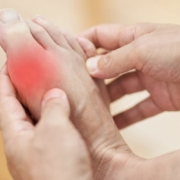How to Prevent Arthritis
Arthritis affects nearly 59 million adult Americans. The disorder occurs when the cartilage that lines the joint is damaged or worn out. This leaves many people wondering how to prevent arthritis. Once joints are worn out, there is no protection for the bones, and they grind against each other every time a joint movement is made. Once the symptoms start, they are usually progressive. The result is constant pain and stiffness, and while many patients can manage the condition with pain medication, steroid injections, and physical therapy, for some, joint replacement is the only option.
Fortunately, the story isn’t all doom and gloom. Preventing arthritis is more than possible. Wondering how to prevent arthritis? Take a look.
- Maintain a healthy body weight. Excess body weight places enormous stress on the joints and is a major risk factor for arthritis. The heavier you are, the more the pressure on your joints. Just one additional pound in body weight places four pounds of pressure on the large weight-bearing joints like the hips and knees. Losing weight can make a major difference in your symptoms. As your body weight drops, the stress on your joints drops significantly.
- Change your footwear. If you want to prevent arthritis, footwear matters. While there’s no one perfect shoe for those looking to prevent arthritis, you should always invest in supportive footwear. Moreover, women should avoid wearing high heels. The human foot was not designed for high heels because the pressure is transmitted to the toes every time they’re worn, creating added stress on the joints.
- Avoid high-impact exercises. High-impact exercises may increase your risk of developing joint pain and osteoarthritis. Common high-impact exercises include cross-training, running, and playing sports like basketball. These exercises place tremendous stress on your joints leading to faster wear and tear of the cartilage. A significant number of individuals who perform high-impact exercise on a regular basis do go on to develop osteoarthritis later in life. If you want to prevent arthritis, instead select low-impact exercises like cycling, swimming, or walking.
- Use proper lifting techniques. Individuals who perform physical tasks like lifting objects may be at risk for arthritis if they adopt bad habits as they lift. The key is to use proper body mechanics and tools to lift very heavy objects. Always keep a wide support base, and use proper posture as you lift. Slowly straighten yourself out by using your hips and your knees, not your back. Most importantly, don’t twist or turn your body while you’re holding heavy objects.
- Protect your joints. Injuries put you at risk for joint damage, which leads to a higher risk of arthritis later in life. Wearing the appropriate safety gear at work or when you play sports is key. Moreover, when you begin a new activity, be sure it agrees with your body. Start slowly. If you feel pain after starting a new sport or a new duty at work, be sure to back off and try to go slower.
- Monitor your Vitamin D intake. It is estimated that nearly two-thirds of Americans may be deficient in vitamin D. This matters to your risk of arthritis because adequate levels of vitamin D generally tend to have a slower progression of arthritis. Ask your healthcare provider to check your vitamin D levels. Calcium and vitamin D supplements are recommended for those with low levels, but it is important to have your levels regularly monitored.
- Drink plenty of water. Experts say that if you want to prevent arthritis, remain hydrated. Cartilage, the cushion between your bones, is made up chiefly of water. When you’re dehydrated, the cartilage shrinks and is at risk for wear and tear. Drinking 6-8 glasses of water a day can help keep the cartilage hydrated and prevent the onset of arthritis.
- Stop smoking. You likely already know that smoking has absolutely no health benefits, but what you may not know is that it can do more harm than good for those working to prevent arthritis. Studies show that smokers are more likely to develop rheumatoid arthritis than non-smokers. More than that, though, if you’ve already developed arthritis, there is ample evidence indicating that smoking is a trigger for painful episodes in patients with both osteoarthritis and rheumatoid arthritis. The nicotine also adversely affects the response to treatment. Patients who smoke tend to be less responsive to the usual anti-arthritic and pain medications compared to non-smokers.
- Treat infections promptly. If you have any type of skin, oral, dental, or other infection, make sure it is treated promptly. Bacteria can easily travel from one place in the body into the joint, and infections of the joint can be devastating and cause permanent disability. If you think you might have an infection close to a joint, seek immediate medical care to make sure that the joint is not contaminated with bacteria.
- Create an ergonomically correct workspace. Whether at home or at work, you want to utilize ergonomics to prevent pain and strain on your joints. If you are sitting at a PC for long hours, ensure that your legs, back, neck and arms are well supported. Select a chair that offers good lumbar support and comes with a headrest. Try to sit up straight and keep both your feet on the footrest or the floor. Keep your wrist straight and set your armrests to form a 90-degree angle. Every hour, take a break and walk around for about 5-10 minutes.
Learning how to prevent arthritis can help stop joint pain later in life. If you have been diagnosed with arthritis, it is important to follow up with a healthcare provider to monitor your condition. Untreated arthritis can lead to permanent destruction of the joint. Today there is good evidence that lifestyle changes can slow down the progression of arthritis and preserve your ability to ambulate. If you’ve been diagnosed with arthritis, it is essential to consult a physical therapist. These professionals can educate you on what exercises you can do safely without causing more joint damage, and show you how to strengthen your muscles and increase the flexibility of your joints.
Arthritis isn’t the end of the world! There are lots of ways to stop joint pain. Contact us today to find out more!





